Studying the Incorporation of Multi-Walled Carbon Nanotubes in High-Performance Concrete
Abstract
:1. Introduction
2. Research Significance and Objectives
3. Materials and Methods
3.1. Raw Materials and Mix Design
3.2. MWCNT Dispersion and Specimen Production
3.3. Flow Test
3.4. Electrical Resistivity
3.5. Mechanical Strength
3.6. Microstructure Observation
4. Results and Discussion
4.1. Flowability
4.2. Electrical Measurements
4.3. Mechanical Strength
4.4. SEM
5. Conclusions and Final Remarks
- The addition of 0.2–0.6% MWCNT in HPC reduced the workability of HPC even with a higher dosage of superplasticiser.
- Adding 0.2–0.6% MWCNT in HPC reduced the electrical resistivity compared to the HPC without nanotubes. The electrical resistivity reached 484.58 Ω m for the HPC without MWCNTs at 28 days of curing, while the samples with 0.2%, 0.4%, and 0.6% MWCNT presented 341.41 Ω m, 363.44 Ω m, and 360.34 Ω m, respectively.
- The use of 0.2–0.6% MWCNT in HPC caused a decrease of 20% and 30% in flexural and compressive strength, respectively.
- SEM observations revealed some regions without MWCNTs, regions with individual MWCNTs within an HPC cementitious matrix, and relatively large agglomerations of long MWCNTs, namely in HPC-0.6% samples.
Author Contributions
Funding
Institutional Review Board Statement
Informed Consent Statement
Data Availability Statement
Acknowledgments
Conflicts of Interest
References
- Randl, N.; Steiner, T.; Ofner, S.; Baumgartner, E.; Mészöly, T. Development of UHPC Mixtures from an Ecological Point of View. Constr. Build. Mater. 2014, 67, 373–378. [Google Scholar] [CrossRef]
- Azmee, N.M.; Shafiq, N. Ultra-High Performance Concrete: From Fundamental to Applications. Case Stud. Constr. Mater. 2018, 9, e00197. [Google Scholar] [CrossRef]
- Park, S.Y.; Kim, S.T.; Cho, J.R.; Lee, J.W.; Kim, B.S. Trial Construction of UHPC Highway Bridge. In Proceedings of the Proceedings of the RILEM-fib-AFGC International Symposium on Ultra-High Performance Fibre-Reinforced Concrete (UHPFRC 2013); International Union of Laboratories and Experts in Construction Materials, Systems and Structures (RILEM): Marseille, France, 2013; pp. 1–3. [Google Scholar]
- Perry, V.H.; Seibert, P. Fifteen Years of UHPC Construction Experience in Precast Bridges in North America. In Proceedings of the RILEM-fib-AFGC Int. Symposium on Ultra-High Performance Fibre-Reinforced Concrete, Marseille, France, 1–3 October 2013; pp. 229–238. [Google Scholar]
- Vítek, J.L.; Čítek, D. Application of UHPC Joints in Bridge Construction–Experimental Testing. Solid State Phenom. 2016, 249, 267–272. [Google Scholar] [CrossRef]
- Brühwiler, E. Rehabilitation and Strengthening of Concrete Structures Using Ultra-High Performance Fibre Reinforced Concrete. In Proceedings of the Proceedings of the 3rd International Conference on Concrete Repair, Rehabilitation and Retrofitting (ICCRRR), Cape Town, South Africa, 3–5 September 2012; CRC Press/Balkema: Boca Raton, FL, USA, 2012; Volume 1, pp. 70–79. [Google Scholar]
- Habert, G.; Denarié, E.; Šajna, A.; Rossi, P. Lowering the Global Warming Impact of Bridge Rehabilitations by Using Ultra High Performance Fibre Reinforced Concretes. Cem. Concr. Compos. 2013, 38, 1–11. [Google Scholar] [CrossRef]
- Racky, P. Cost-Effectiveness and Sustainability of UHPC. In Proceedings of the International Symposium on Ultra High Performance Concrete, Kassel, Germany, 13–15 September 2004; pp. 797–805. [Google Scholar]
- Abbas, S.; Nehdi, M.L.; Saleem, M.A. Ultra-High Performance Concrete: Mechanical Performance, Durability, Sustainability and Implementation Challenges. Int. J. Concr. Struct. Mater. 2016, 10, 271–295. [Google Scholar] [CrossRef]
- Schmidt, M.; Teichmann, T. Ultra-High-Performance Concrete: Basis for Sustainable Structures. In Proceedings of the Central Europe towards Sustainable Building, Prague, Czech Republic, 24–26 September 2007; pp. 83–88. [Google Scholar]
- Lothenbach, B.; Scrivener, K.; Hooton, R.D. Supplementary Cementitious Materials. Cem. Concr. Res. 2011, 41, 1244–1256. [Google Scholar] [CrossRef]
- Jensen, O.M.; Kovler, K.; de Belie, N. Concrete with Supplementary Cementitious Materials; RILEM: Paris, France, 2016; ISBN 9782351581780. [Google Scholar]
- Jung, M.; Lee, Y.-S.; Hong, S.-G. Effect of Incident Area Size on Estimation of EMI Shielding Effectiveness for Ultra-High Performance Concrete with Carbon Nanotubes. IEEE Access 2019, 7, 183105–183117. [Google Scholar] [CrossRef]
- D’Alessandro, A.; Pisello, A.L.; Fabiani, C.; Ubertini, F.; Cabeza, L.F.; Cotana, F. Multifunctional Smart Concretes with Novel Phase Change Materials: Mechanical and Thermo-Energy Investigation. Appl. Energy 2018, 212, 1448–1461. [Google Scholar] [CrossRef]
- Han, B.; Ding, S.; Yu, X. Intrinsic Self-Sensing Concrete and Structures: A Review. Measurement 2015, 59, 110–128. [Google Scholar] [CrossRef]
- Calvo, J.L.G.; Pérez, G.; Carballosa, P.; Erkizia, E.; Gaitero, J.J.; Guerrero, A. Development of Ultra-High Performance Concretes with Self-Healing Micro/Nano-Additions. Constr. Build. Mater. 2017, 138, 306–315. [Google Scholar] [CrossRef]
- Sanchez, F.; Sobolev, K. Nanotechnology in Concrete—A Review; Elsevier: Amsterdam, The Netherlands, 2010; Volume 24. [Google Scholar]
- D’Alessandro, A.; Materazzi, A.L.; Ubertini, F. (Eds.) Nanotechnology in Cement-Based Construction; Jenny Stanforf Publishing Pte. Ltd.: Singapore, 2020; ISBN 978-981-4800-76-1. [Google Scholar]
- Konsta-Gdoutos, M.S.; Metaxa, Z.S.; Shah, S.P. Multi-Scale Mechanical and Fracture Characteristics and Early-Age Strain Capacity of High Performance Carbon Nanotube/Cement Nanocomposites. Cem. Concr. Compos. 2010, 32, 110–115. [Google Scholar] [CrossRef]
- Siahkouhi, M.; Razaqpur, G.; Hoult, N.A.; Baghban, M.H.; Jing, G. Utilization of Carbon Nanotubes (CNTs) in Concrete for Structural Health Monitoring (SHM) Purposes: A Review. Constr. Build. Mater. 2021, 309, 125137. [Google Scholar] [CrossRef]
- Al-Dahawi, A.; Öztürk, O.; Emami, F.; Yıldırım, G.; Şahmaran, M. Effect of Mixing Methods on the Electrical Properties of Cementitious Composites Incorporating Different Carbon-Based Materials. Constr. Build. Mater. 2016, 104, 160–168. [Google Scholar] [CrossRef]
- Jang, D.; Yoon, H.N.; Seo, J.; Yang, B. Effects of Exposure Temperature on the Piezoresistive Sensing Performances of MWCNT-Embedded Cementitious Sensor. J. Build. Eng. 2022, 47, 103816. [Google Scholar] [CrossRef]
- Grobert, N. Carbon Nanotubes–Becoming Clean. Mater. Today 2007, 10, 28–35. [Google Scholar] [CrossRef]
- Li, G.Y.; Wang, P.M.; Zhao, X. Mechanical Behavior and Microstructure of Cement Composites Incorporating Surface-Treated Multi-Walled Carbon Nanotubes. Carbon 2005, 43, 1239–1245. [Google Scholar] [CrossRef]
- Raki, L.; Beaudoin, J.; Alizadeh, R.; Makar, J.; Sato, T. Cement and Concrete Nanoscience and Nanotechnology. Materials 2010, 3, 918–942. [Google Scholar] [CrossRef]
- Lian, J.; Hu, C.; Fu, T.; Wang, Y. Review of Self-Sensing Capability of Ultra-High Performance Concrete. Front. Mater. 2021, 8, 746022. [Google Scholar] [CrossRef]
- Chen, S.J.; Zou, B.; Collins, F.; Zhao, X.L.; Majumber, M.; Duan, W.H. Predicting the Influence of Ultrasonication Energy on the Reinforcing Efficiency of Carbon Nanotubes. Carbon 2014, 77, 1–10. [Google Scholar] [CrossRef]
- Shamsaei, E.; de Souza, F.B.; Yao, X.; Benhelal, E.; Akbari, A.; Duan, W. Graphene-Based Nanosheets for Stronger and More Durable Concrete: A Review. Constr. Build. Mater. 2018, 183, 642–660. [Google Scholar] [CrossRef]
- Sharma, S.; Kothiyal, N.C.; Chitkara, M. Enhanced Mechanical Performance of Cement Nanocomposite Reinforced with Graphene Oxide Synthesized from Mechanically Milled Graphite and Its Comparison with Carbon Nanotubes Reinforced Nanocomposite. RSC Adv. 2016, 6, 103993–104009. [Google Scholar] [CrossRef]
- Li, X.; Wei, W.; Qin, H.; Hu, Y.H. Co-Effects of Graphene Oxide Sheets and Single Wall Carbon Nanotubes on Mechanical Properties of Cement. J. Phys. Chem. Solids 2015, 85, 39–43. [Google Scholar] [CrossRef]
- Mokhtar, M.M.; Abo-El-Enein, S.A.; Hassaan, M.Y.; Morsy, M.S.; Khalil, M.H. Mechanical Performance, Pore Structure and Micro-Structural Characteristics of Graphene Oxide Nano Platelets Reinforced Cement. Constr. Build. Mater. 2017, 138, 333–339. [Google Scholar] [CrossRef]
- Tong, T.; Fan, Z.; Liu, Q.; Wang, S.; Tan, S.; Yu, Q. Investigation of the Effects of Graphene and Graphene Oxide Nanoplatelets on the Micro-and Macro-Properties of Cementitious Materials. Constr. Build. Mater. 2016, 106, 102–114. [Google Scholar] [CrossRef]
- Liebscher, M.; Dinh, T.T.; Schroefl, C.; Mechtcherine, V. Dispersion of Different Carbon-Based Nanofillers in Aqueous Suspension by Polycarboxylate Comb-Type Copolymers and Their Influence on the Early Age Properties of Cementitious Matrices. Constr. Build. Mater. 2020, 241, 118039. [Google Scholar] [CrossRef]
- Eisa, M.S.; Mohamady, A.; Basiouny, M.E.; Abdulhamid, A.; Kim, J.R. Mechanical Properties of Asphalt Concrete Modified with Carbon Nanotubes (CNTs). Case Stud. Constr. Mater. 2022, 16, e00930. [Google Scholar] [CrossRef]
- Chang, F.; Markmiller, J.F.C.; Yang, J.; Kim, Y. Structural Health Monitoring. In System Health Management: With Aerospace Applications; Wiley: Hoboken, NJ, USA, 2011; pp. 419–428. [Google Scholar] [CrossRef]
- de Almeida Carísio, P.; Mendoza Reales, O.A.; Toledo Filho, R.D. Evaluation of Mechanical Properties of Cement-Based Composites with Nanomaterials. In Nanotechnology in Cement-Based Construction; D’Alessandro, A., Materazzi, A.A.L., Ubertini, F., Eds.; Jenny Stanford Publishing: Dubai, United Arab Emirates, 2020; pp. 145–172. [Google Scholar]
- Reales, O.A.M.; Toledo Filho, R.D. A Review on the Chemical, Mechanical and Microstructural Characterization of Carbon Nanotubes-Cement Based Composites. Constr. Build. Mater. 2017, 154, 697–710. [Google Scholar] [CrossRef]
- Wu, Z.; Shi, C.; Khayat, K.H.; Wan, S. Effects of Different Nanomaterials on Hardening and Performance of Ultra-High Strength Concrete (UHSC). Cem. Concr. Compos. 2016, 70, 24–34. [Google Scholar] [CrossRef]
- Janković, K.; Bojović, D.; Stojanović, M. Influence of Nanoparticles on the Strength of Ultra-High Performance Concrete. In Nanotechnology in Eco-efficient Construction; Elsevier: Amsterdam, The Netherlands, 2019; pp. 13–42. [Google Scholar]
- Huang, H.; Teng, L.; Khayat, K.H.; Gao, X.; Wang, F.; Liu, Z. For the Improvement of Mechanical and Microstructural Properties of UHPC with Fiber Alignment Using Carbon Nanotube and Graphite Nanoplatelet. Cem. Concr. Compos. 2022, 129, 104462. [Google Scholar] [CrossRef]
- Yoo, D.-Y.; Kim, S.; Lee, S.H. Self-Sensing Capability of Ultra-High-Performance Concrete Containing Steel Fibers and Carbon Nanotubes under Tension. Sens. Actuators A Phys. 2018, 276, 125–136. [Google Scholar] [CrossRef]
- Lee, S.H.; Kim, S.; Yoo, D.-Y. Hybrid Effects of Steel Fiber and Carbon Nanotube on Self-Sensing Capability of Ultra-High-Performance Concrete. Constr. Build. Mater. 2018, 185, 530–544. [Google Scholar] [CrossRef]
- Jung, M.; Lee, Y.; Hong, S.-G.; Moon, J. Carbon Nanotubes (CNTs) in Ultra-High Performance Concrete (UHPC): Dispersion, Mechanical Properties, and Electromagnetic Interference (EMI) Shielding Effectiveness (SE). Cem. Concr. Res. 2020, 131, 106017. [Google Scholar] [CrossRef]
- Jung, M.; Park, J.; Hong, S.-G.; Moon, J. Micro-and Meso-Structural Changes on Electrically Cured Ultra-High Performance Fiber-Reinforced Concrete with Dispersed Carbon Nanotubes. Cem. Concr. Res. 2020, 137, 106214. [Google Scholar] [CrossRef]
- Meng, W.; Khayat, K.H. Effect of Graphite Nanoplatelets and Carbon Nanofibers on Rheology, Hydration, Shrinkage, Mechanical Properties, and Microstructure of UHPC. Cem. Concr. Res. 2018, 105, 64–71. [Google Scholar] [CrossRef]
- Chen, Z.; Lim, J.L.G.; Yang, E.-H. Ultra High Performance Cement-Based Composites Incorporating Low Dosage of Plasma Synthesized Carbon Nanotubes. Mater. Des. 2016, 108, 479–487. [Google Scholar] [CrossRef]
- Li, H.; Xiao, H.; Yuan, J.; Ou, J. Microstructure of Cement Mortar with Nanoparticles. Compos. B Eng. 2004, 35, 185–189. [Google Scholar] [CrossRef]
- Lee, S.-J.; You, I.; Kim, S.; Shin, H.-O.; Yoo, D.-Y. Self-Sensing Capacity of Ultra-High-Performance Fiber-Reinforced Concrete Containing Conductive Powders in Tension. Cem. Concr. Compos. 2022, 125, 104331. [Google Scholar] [CrossRef]
- Mendoza, O.; Sierra, G.; Tobón, J.I. Influence of Super Plasticizer and Ca(OH)2 on the Stability of Functionalized Multi-Walled Carbon Nanotubes Dispersions for Cement Composites Applications. Constr. Build. Mater. 2013, 47, 771–778. [Google Scholar] [CrossRef]
- Silvestro, L.; Lima, G.T.D.S.; Ruviaro, A.S.; Gleize, P.J.P. Stability of Carboxyl-Functionalized Carbon Nanotubes in Simulated Cement Pore Solution and Its Effect on the Compressive Strength and Porosity of Cement-Based Nanocomposites. C 2022, 8, 39. [Google Scholar] [CrossRef]
- Jung, M.; Park, J.; Hong, S.; Moon, J. The Critical Incorporation Concentration (CIC) of Dispersed Carbon Nanotubes for Tailoring Multifunctional Properties of Ultra-High Performance Concrete (UHPC). J. Mater. Res. Technol. 2022, 17, 3361–3370. [Google Scholar] [CrossRef]
- EN 197-1:2011; Cement—Part 1: Composition, Specifications and Conformity Criteria for Common Cements. CEN: Brussels, Belgium, 2011.
- EN 933-1:2012; Tests for Geometrical Properties of Aggregates—Part 1: Determination of Particle Size Distribution—Sieving Method. CEN: Brussels, Belgium, 2012.
- Barbosa, A.M.M.T. Design of Eco-Efficient Ultra-High Performance Fibre Reinforced Cement-Based Composite for Rehabilitation/Strengthening Applications. Ph.D. Thesis, Universidade do Porto, Porto, Portugal, 2020. [Google Scholar]
- Matos, A.M.; Nunes, S.; Costa, C.; Barroso-Aguiar, J.L. Spent Equilibrium Catalyst as Internal Curing Agent in UHPFRC. Cem. Concr. Compos. 2019, 104, 103362. [Google Scholar] [CrossRef]
- Matos, A.M.; Nunes, S.; Costa, C.; Barroso-Aguiar, J.L. Characterization of Non-Proprietary UHPC for Use in Rehabilitation/Strengthening Applications. In Rheology and Processing of Construction Materials: RheoCon2 & SCC9 2; Springer: Berlin/Heidelberg, Germany, 2020; pp. 552–559. [Google Scholar]
- Silvestro, L.; dos Santos Lima, G.T.; Ruviaro, A.S.; Mezalira, D.Z.; Gleize, P.J.P. Effect of Multi-walled Carbon Nanotube Functionalization with 3-Aminopropyltriethoxysilane on the Rheology and Early-Age Hydration of Portland Cement Pastes. J. Mater. Civ. Eng. 2022, 34, 4022176. [Google Scholar] [CrossRef]
- Silvestro, L.; dos Santos Lima, G.T.; Ruviaro, A.S.; de Matos, P.R.; Mezalira, D.Z.; Gleize, P.J.P. Evaluation of Different Organosilanes on Multi-Walled Carbon Nanotubes Functionalization for Application in Cementitious Composites. J. Build. Eng. 2022, 51, 104292. [Google Scholar] [CrossRef]
- EN 196-1:2016; Methods of Testing Cement—Part 1: Determination of Strength. CEN: Brussels, Belgium, 2016.
- EFNARC Specification and Guidelines for Self-Compacting Concrete. 2002. Available online: https://wwwp.feb.unesp.br/pbastos/c.especiais/Efnarc.pdf (accessed on 15 April 2022).
- Polder, R.B. Test Methods for on Site Measurement of Resistivity of Concrete—A RILEM TC-154 Technical Recommendation. Constr. Build. Mater. 2001, 15, 125–131. [Google Scholar] [CrossRef]
- Jung, M.; Park, J.; Hong, S.; Moon, J. Electrically Cured Ultra-High Performance Concrete (UHPC) Embedded with Carbon Nanotubes for Field Casting and Crack Sensing. Mater. Des. 2020, 196, 109127. [Google Scholar] [CrossRef]
- Sengul, O. Use of Electrical Resistivity as an Indicator for Durability. Constr. Build. Mater. 2014, 73, 434–441. [Google Scholar] [CrossRef]
- Xiao, L. Interpretation of Hydration Process of Concrete Based on Electrical Resistivity Measurement. Available online: http://lbezone.ust.hk/pdfviewer/web/viewer.html?file=aHR0cDovL2xiZXpvbmUudXN0LmhrL29iai8xL28vYjk0MzY5My9iOTQzNjkzLnBkZg== (accessed on 13 June 2017).
- de Grazia, M.T.; Deda, H.; Sanchez, L.F. The Influence of the Binder Type & Aggregate Nature on the Electrical Resistivity of Conventional Concrete. J. Build. Eng. 2021, 43, 102540. [Google Scholar] [CrossRef]
- García-Macías, E.; D’Alessandro, A.; Castro-Triguero, R.; Pérez-Mira, D.; Ubertini, F. Micromechanics Modeling of the Electrical Conductivity of Carbon Nanotube Cement-Matrix Composites. Compos. B Eng. 2017, 108, 451–469. [Google Scholar] [CrossRef]
- Lim, K.; Lee, N.; Ryu, G.; Koh, K.; Kim, K. Electrical Characteristics of Ultra-High-Performance Concrete Containing Carbon-Based Materials. Appl. Sci. 2022, 12, 7858. [Google Scholar] [CrossRef]
- Yoo, D.-Y.; Oh, T.; Banthia, N. Nanomaterials in Ultra-High-Performance Concrete (UHPC)—A Review. Cem. Concr. Compos. 2022, 134, 104730. [Google Scholar] [CrossRef]
- Seo, J.; Jang, D.; Yang, B.; Yoon, H.N.; Jang, J.G.; Park, S.; Lee, H.K. Material Characterization and Piezoresistive Sensing Capability Assessment of Thin-Walled CNT-Embedded Ultra-High Performance Concrete. Cem. Concr. Compos. 2022, 134, 104808. [Google Scholar] [CrossRef]
- Sobolkina, A.; Mechtcherine, V.; Khavrus, V.; Maier, D.; Mende, M.; Ritschel, M.; Leonhardt, A. Dispersion of Carbon Nanotubes and Its Influence on the Mechanical Properties of the Cement Matrix. Cem. Concr. Compos. 2012, 34, 1104–1113. [Google Scholar] [CrossRef]
- Cui, X.; Han, B.; Zheng, Q.; Yu, X.; Dong, S.; Zhang, L.; Ou, J. Mechanical Properties and Reinforcing Mechanisms of Cementitious Composites with Different Types of Multi-walled Carbon Nanotubes. Compos. Part. A Appl. Sci. Manuf. 2017, 103, 131–147. [Google Scholar] [CrossRef]
- Zhang, W.; Zeng, W.; Zhang, Y.; Yang, F.; Wu, P.; Xu, G.; Gao, Y. Investigating the Influence of Multi-Walled Carbon Nanotubes on the Mechanical and Damping Properties of Ultra-High Performance Concrete. Sci. Eng. Compos. Mater. 2020, 27, 433–444. [Google Scholar] [CrossRef]
- Abu Al-Rub, R.K.; Ashour, A.I.; Tyson, B.M. On the Aspect Ratio Effect of Multi-Walled Carbon Nanotube Reinforcements on the Mechanical Properties of Cementitious Nanocomposites. Constr. Build. Mater. 2012, 35, 647–655. [Google Scholar] [CrossRef]
- Han, B.; Yang, Z.; Shi, X.; Yu, X. Transport Properties of Carbon-Nanotube/Cement Composites. J. Mater. Eng. Perform. 2013, 22, 184–189. [Google Scholar] [CrossRef]
- Nochaiya, T.; Chaipanich, A. Behavior of Multi-Walled Carbon Nanotubes on the Porosity and Microstructure of Cement-Based Materials. Appl. Surf. Sci. 2011, 257, 1941–1945. [Google Scholar] [CrossRef]
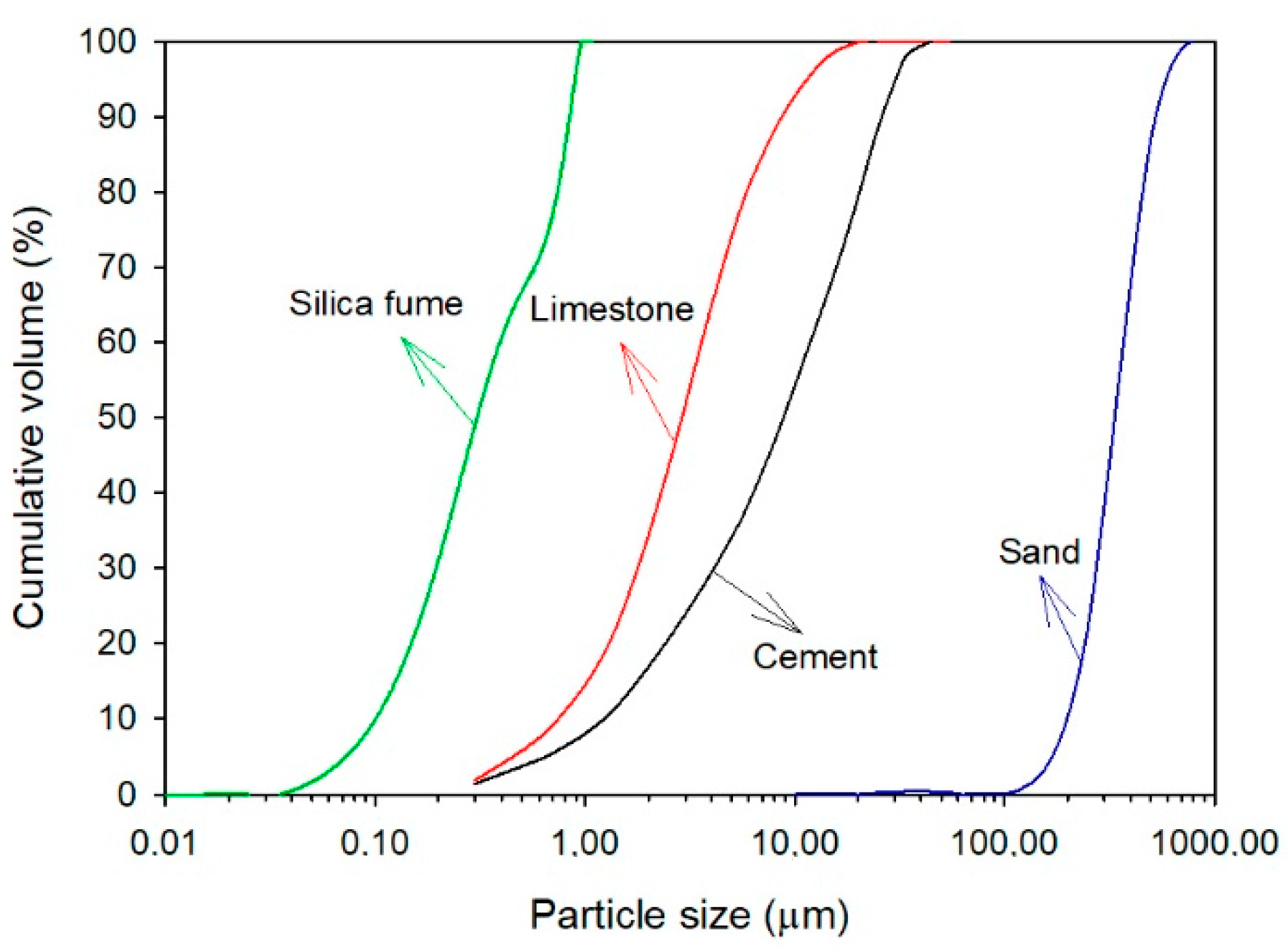

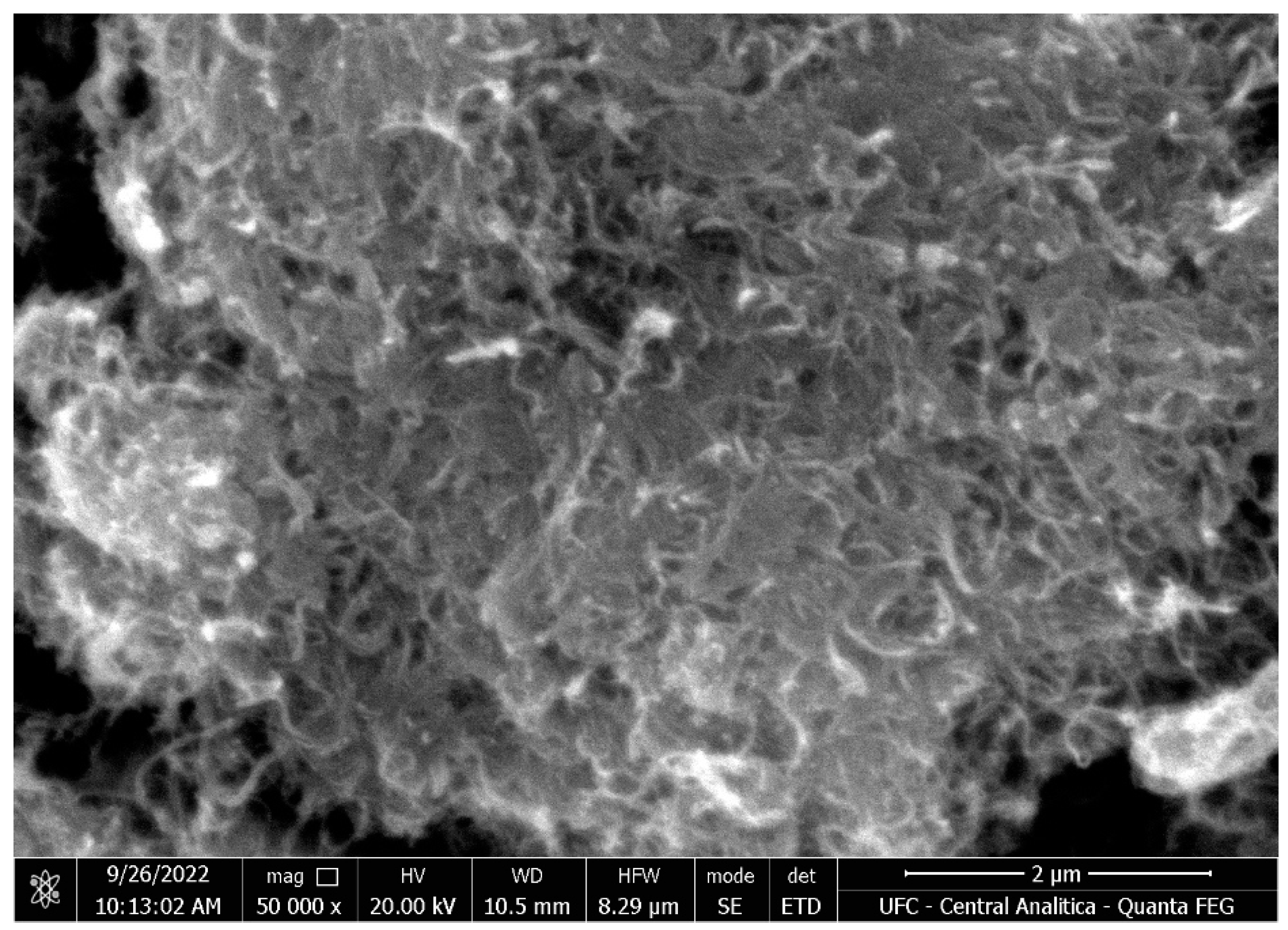

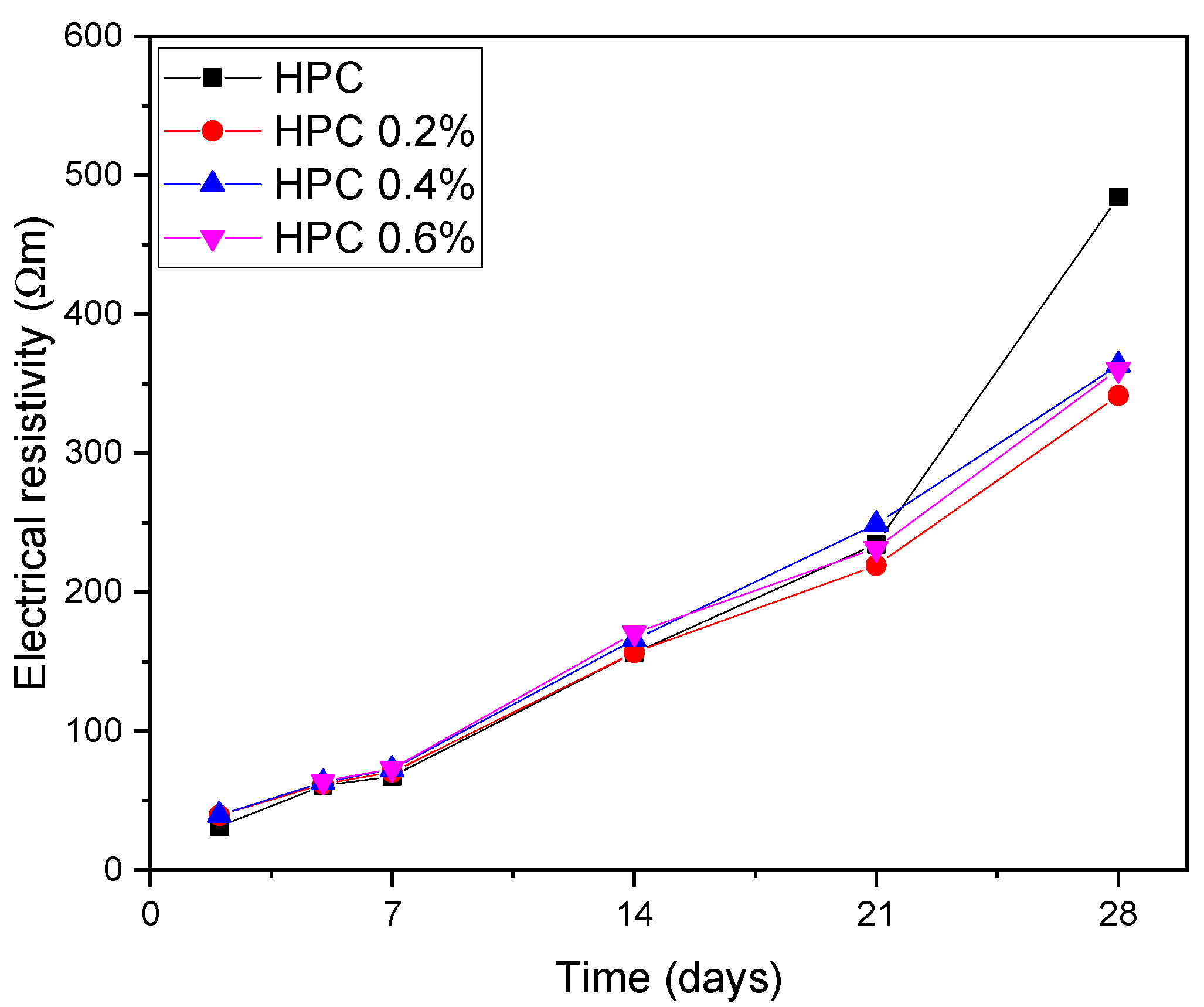

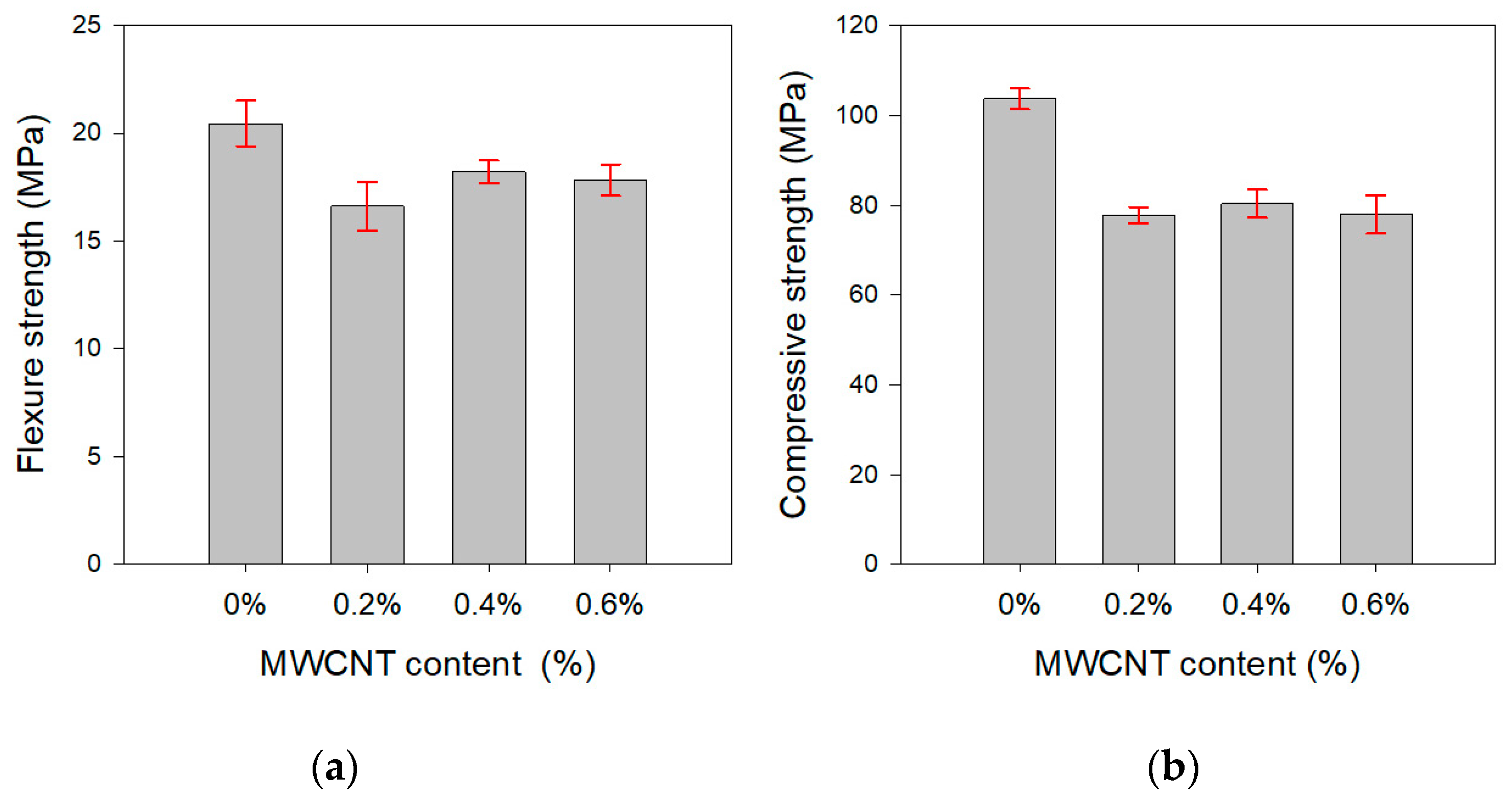
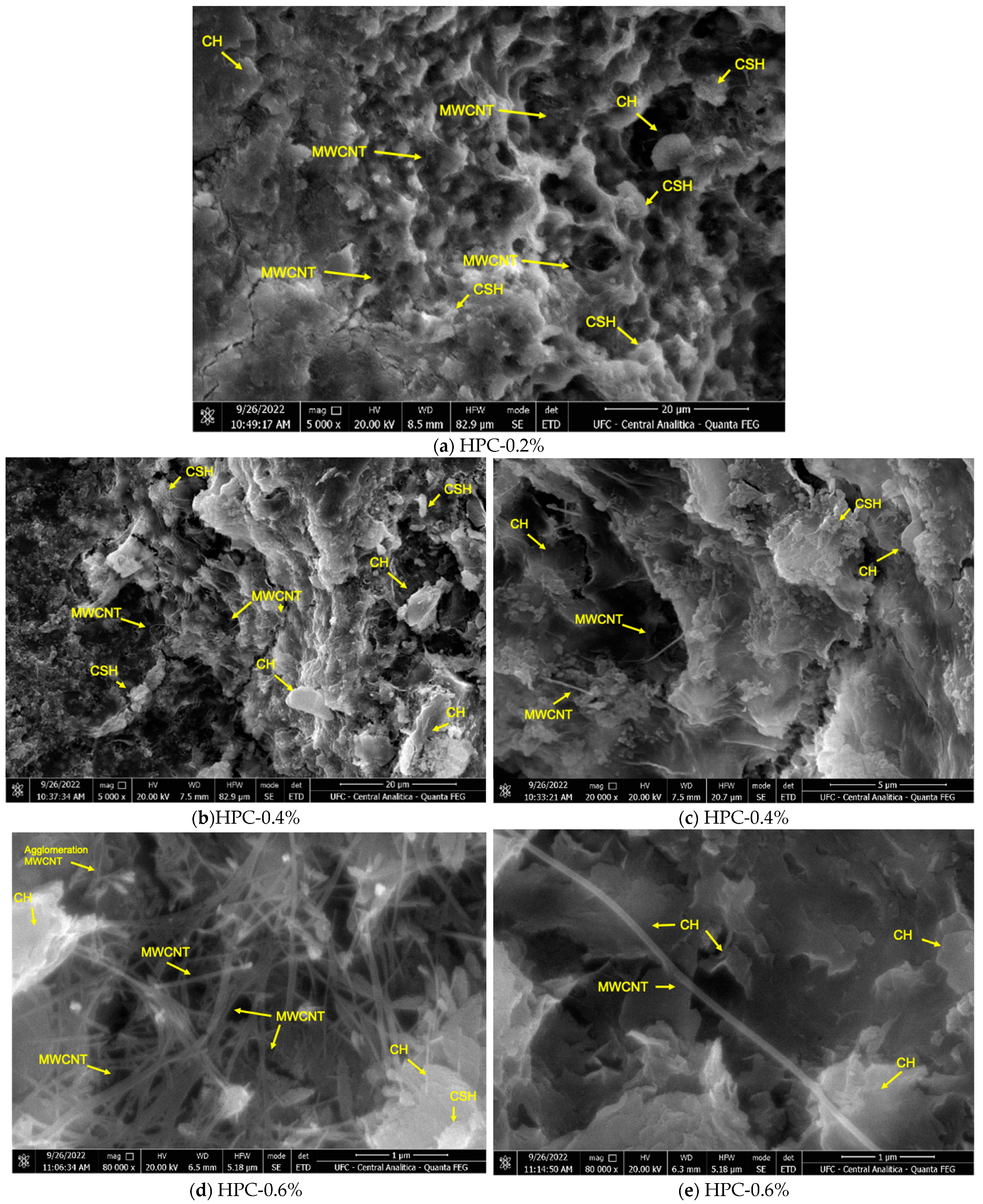
| Chemical Composition (%) | Physical Properties | ||||||||||||
|---|---|---|---|---|---|---|---|---|---|---|---|---|---|
| LOI | SiO2 | Al2O3 | Fe2O3 | CaO | MgO | Na2O | K2O | SO3 | Cl | Free Lime | Density (kg/m3) | Specific Surface (g/cm) | |
| Cement | 2.7 | 19.4 | 5.12 | 3.28 | 62.3 | 1.57 | 0.13 | 0.6 | 3.22 | 0.05 | 1.28 | 3110 | 4395 * |
| Silica fume | <3 | >90 | - | - | - | - | - | - | - | - | - | 2200 | 19632 ** |
| Limestone filler | - | - | - | 0.02 | 99 | 0.3 | - | - | <0.05 | <0.001 | - | 2680 | 5400 * |
| Parameter | Values |
|---|---|
| Length | 0.5–15 µm |
| Average length | 4.5 μm |
| Diameter range | 8–45 µm |
| Average diameter | 20 nm |
| Specific mass | 2.1 g/cm3 |
| Purity | ≥95% |
| Specific surface area | 40–300 m2/g |
| Functionalisation | 9% |
| Constituent Materials Dosage (kg/m3) | Main Ratios | ||||||||
|---|---|---|---|---|---|---|---|---|---|
| Mix ID | Cement | LF | SF | MWCNT | Sp | Water | w/b | Sp/b (%) | MWCNT/c (%) |
| HPC-0.0% | 790.40 | 311.43 | 39.52 | - | 30.0 | 165 | 0.145 | 2.63 | - |
| HPC-0.2% | 790.40 | 311.43 | 39.52 | 1.58 | 37.5 | 165 | 0.145 | 3.29 | 0.2 |
| HPC-0.4% | 790.40 | 311.43 | 39.52 | 3.16 | 37.5 | 165 | 0.145 | 3.29 | 0.4 |
| HPC-0.6% | 790.40 | 311.43 | 39.52 | 4.74 | 37.5 | 165 | 0.145 | 3.29 | 0.6 |
Disclaimer/Publisher’s Note: The statements, opinions and data contained in all publications are solely those of the individual author(s) and contributor(s) and not of MDPI and/or the editor(s). MDPI and/or the editor(s) disclaim responsibility for any injury to people or property resulting from any ideas, methods, instructions or products referred to in the content. |
© 2023 by the authors. Licensee MDPI, Basel, Switzerland. This article is an open access article distributed under the terms and conditions of the Creative Commons Attribution (CC BY) license (https://creativecommons.org/licenses/by/4.0/).
Share and Cite
Mesquita, E.; Matos, A.M.; Sousa, I.; Vieira, M.; Santos, L.P.M. Studying the Incorporation of Multi-Walled Carbon Nanotubes in High-Performance Concrete. Sustainability 2023, 15, 12958. https://doi.org/10.3390/su151712958
Mesquita E, Matos AM, Sousa I, Vieira M, Santos LPM. Studying the Incorporation of Multi-Walled Carbon Nanotubes in High-Performance Concrete. Sustainability. 2023; 15(17):12958. https://doi.org/10.3390/su151712958
Chicago/Turabian StyleMesquita, Esequiel, Ana Mafalda Matos, Israel Sousa, Mylene Vieira, and Luís P. M. Santos. 2023. "Studying the Incorporation of Multi-Walled Carbon Nanotubes in High-Performance Concrete" Sustainability 15, no. 17: 12958. https://doi.org/10.3390/su151712958










